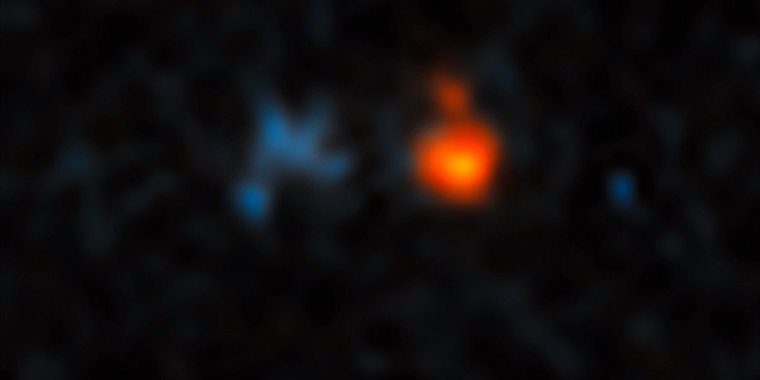| News / Space News |
Astronomers Study How Quasars Are Powered by Accretion Disks
Astronomers are studying quasars to see if and how accretion disks are fueled with external mass.

This is a Hubble Space Telescope image of a very distant quasar (at right) that has been magnified and split into three images by the effects of the gravitational field of a foreground galaxy (left). The image shows the quasar as it looked 12.8 billion years ago — only about 1 billion years after the big bang. The quasar appears red because its blue light has been absorbed by diffuse gas in intergalactic space. Photo: NASA, ESA and X. Fan (University of Arizona)
“The supermassive black hole in the center of the quasar gobbles up an enormous amount of nearby materials, which glare and shine when they constitute an accretion disk before finally sliding down in the black hole,” said Hongyan Zhou, faculty member at the University of Science and Technology of China about the universe’s brightest beacons; shining with magnitudes more luminosity than entire galaxies and the stars they contain.
In the center of this light, at the heart of a quasar, researchers think, is an all-consuming black hole.
Outside the accretion disk, materials are continuously pumped from all directions to the center by gravity to feed the black hole with an endless appetite.
Researchers, for the first time, have observed the accelerated rate at which eight quasars consume interstellar fuel to feed their black holes.
As the most luminous steady beacons in the Universe, quasars are believed to be powered by an accretion disk around the central black hole.
An accretion disk is a spiraling mass of material centered around a monumental source of gravity consuming interstellar material–what researchers have theorized is a black hole. Much like how water empties out of a bathtub, the material spins much faster the closer it gets to the drain.
The interstellar gas cannot be observed directly, as its radiation signature is overwhelmed by the accretion disk’s brightness. Instead, researchers monitor for gas falling into the accretion disk that may pass through their line of sight.
The gas makes a kind of eclipse between Earth and the accretion disk, casting lines onto the disk’s spectrum of radiation.
The researchers used the Doppler effect to measure these lines and observe the velocity of gas feeding into the disk, toward the black hole. A classic Doppler effect example is how the pitch of a police siren drops once it passes.
Astronomers call this passing pitch the “redshift” when measuring how quickly gases move toward an object away from Earth. Zhou and his team measured velocities of 5,000 kilometers per second.
Such a high velocity can only be accelerated by the strong gravity of the central black hole.
In the quasars Zhou observed, the accretion disks were supplied with fast-falling external mass from surrounding space. The disks themselves then create inflows to the black hole. (Tasnim News Agency)
YOU MAY ALSO LIKE





